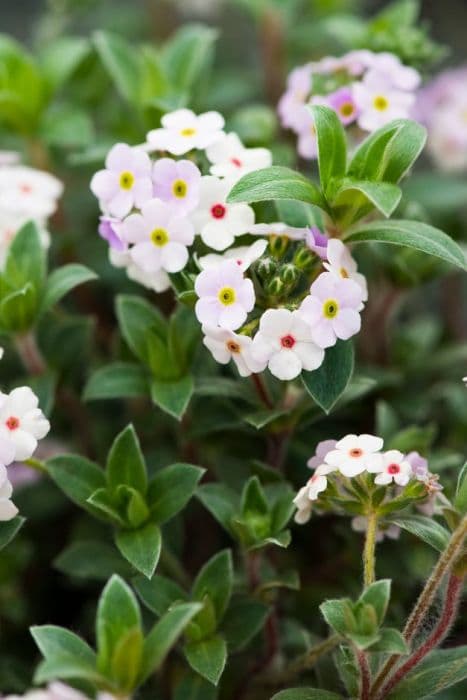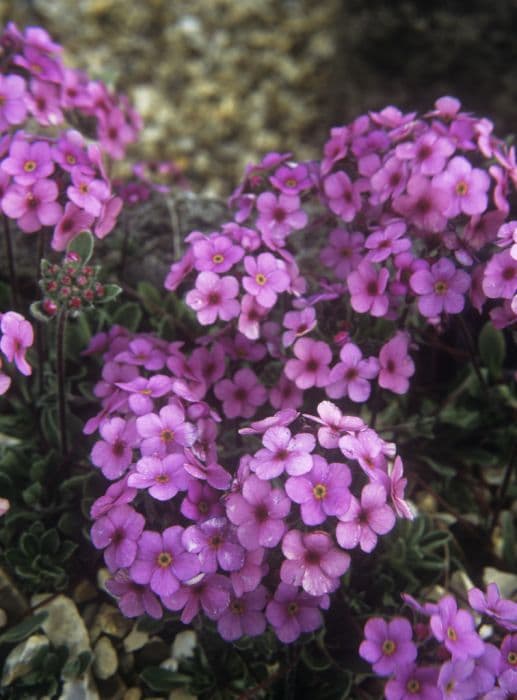Persian Violet Cyclamen 'Miracle Deep Salmon'

ABOUT
Cyclamen 'Miracle Deep Salmon' is known for its distinct and vibrant flowers which bear a deep salmon-pink hue. These blossoms are characterized by their swept-back petals that give them an elegant, reflexed appearance, resembling a group of butterflies fluttering just above the foliage. The heart-shaped leaves of the Cyclamen are equally attractive, featuring a dark green color with a silver marbling pattern that provides a beautiful contrast to the vivid flowers. The plant exhibits a tidy, compact growth habit, presenting a lush and full appearance with the leaves forming a low, rounded mound beneath the canopy of striking flowers. This Cyclamen variety creates an eye-catching display with its rich coloring and graceful floral presentation.
About this plant
 Names
NamesFamily
Primulaceae
Synonyms
Persian Violet, Sowbread
Common names
Cyclamen persicum 'Miracle Deep Salmon'
 Toxicity
ToxicityTo humans
Cyclamen, specifically Cyclamen 'Miracle Deep Salmon', contains toxic compounds called terpenoid saponins. These substances can cause poisoning if ingested by humans. Symptoms of cyclamen poisoning may include gastrointestinal discomfort such as nausea, vomiting, and diarrhea. In severe cases, ingestion of large amounts could potentially result in more serious symptoms such as heart rhythm abnormalities or seizures.
To pets
Cyclamen is toxic to pets including cats and dogs. The most toxic part of the plant is the tuber or root. If ingested, it can cause symptoms such as drooling, vomiting, and diarrhea in pets. In severe cases, ingestion might lead to heart rhythm abnormalities, seizures or even death, especially if a large amount is consumed.
 Characteristics
CharacteristicsLife cycle
Perennials
Foliage type
Evergreen
Color of leaves
Varies
Flower color
Deep Salmon
Height
6 inches (15 cm)
Spread
6 inches (15 cm)
Plant type
Bulb
Hardiness zones
5
Native area
Middle East Mediterranean
Benefits
 General Benefits
General Benefits- Eye-catching Blooms: Cyclamen 'Miracle Deep Salmon' has vibrant, salmon-colored flowers that add a splash of color to any garden or indoor space.
- Long Flowering Period: This plant typically has a prolonged blooming period, offering ornamental value over an extended time.
- Compact Size: It is well-suited for small spaces or as a tabletop plant due to its compact growth habit.
- Low Maintenance: Requires minimal care, making it a good choice for those with a busy lifestyle or those new to gardening.
- Cool Weather Tolerance: Thrives in cooler temperatures, which makes it an excellent plant for fall and early spring color.
- Attracts Pollinators: The flowers can attract butterflies and other pollinators, enhancing the biodiversity of your garden.
- Seasonal Interest: Adds seasonal interest to gardens, especially when most other plants are not in bloom.
 Medical Properties
Medical PropertiesThis plant is not used for medical purposes.
 Air-purifying Qualities
Air-purifying QualitiesThis plant is not specifically known for air purifying qualities.
 Other Uses
Other Uses- Cyclamen petals can be used in crafting to create natural dyes, giving fabrics a subtle hue that can vary depending on the mordants used.
- Pressed Cyclamen flowers can be incorporated into unique pieces of handmade jewelry, preserving the beauty of the bloom within resin pendants or earrings.
- The sturdy leaves of Cyclamen can serve as natural stencils for painting and creative arts projects.
- Dried Cyclamen blooms can be added to potpourri mixtures to enhance the visual appeal and add a touch of fragrance.
- Cyclamen plants can be used in a vivarium setup to simulate a natural environment for reptiles and amphibians who prefer cooler habitats.
- During festive seasons, Cyclamen plants can be arranged into living ornaments or centerpieces for tables.
- Cyclamen leaves can be used as bookmarks, offering an organic and delicate touch to the reading experience.
- A class project may use Cyclamen growth patterns to teach students about plant biology and the life cycle of a flowering plant.
- Cyclamen plants can be part of a sensory garden for therapeutic horticultural practices due to their varied textures and colors.
- Photographers can use Cyclamen plants as a subject for macro photography, capturing the intricate patterns of the flowers and leaves.
Interesting Facts
 Feng Shui
Feng ShuiThe Cyclamen is not used in Feng Shui practice.
 Zodiac Sign Compitability
Zodiac Sign CompitabilityThe Cyclamen is not used in astrology practice.
 Plant Symbolism
Plant Symbolism- Love and Devotion: Cyclamens often symbolize deep love and devotion with their heartfelt and vibrant appearance, making them ideal to express sincere affection.
- Resignation and Goodbye: In some cultures, cyclamens are associated with goodbye or the end of a relationship, representing a graceful exit or a respectful parting.
- Sincerity: The Cyclamen's upright stance and open flowers are often seen as emblematic of sincerity, openness, and honest communication.
- Compassion: Given as gifts, cyclamens may symbolize sympathy and compassion, offering support and understanding to someone going through a difficult time.
 Water
WaterThe Cyclamen, or Persian Violet, requires careful watering to encourage proper growth. It’s important to water the plant only when the top inch of soil feels dry to the touch; over-watering can lead to rot. Typically, this may translate to watering once a week, but this can vary depending on the environment's humidity and temperature levels. A moderate amount of water should be added, around 8-16 ounces, directly onto the soil, avoiding the leaves and flowers to prevent disease. During the plant's dormant period in the summer, reduce watering until new growth appears in the fall.
 Light
LightCyclamen prefer bright, indirect light, away from direct sunlight which can scorch the leaves. The ideal spot for Persian Violet is a north or east-facing window with filtered light. However, during the winter months when light levels are low, they can tolerate some direct sunlight. Avoid placing them in very dark or overly bright spots, as this can inhibit their growth or cause damage.
 Temperature
TemperaturePersian Violet thrives in cooler temperatures, ideally between 60 to 68 degrees Fahrenheit, and they can survive in a temperature range of 50 to 70 degrees Fahrenheit. Avoid exposing the plant to temperatures above 70 degrees or below 50 degrees, as this can cause stress or damage to the plant. The cooler night temperatures help to prolong the blooming period.
 Pruning
PruningPruning is essential for Cyclamen to remove faded flowers and yellowing leaves, which encourages new growth and blooms. Use clean, sharp scissors to cut the stems of spent flowers at the base. Pruning should be done as needed throughout the flowering season. After blooming, the Persian Violet leaves will yellow and die back as the plant enters dormancy, at which point you should also remove the dead foliage.
 Cleaning
CleaningAs needed
 Soil
SoilCyclamen prefers well-drained soil with high organic matter. A mix of potting soil, peat moss, and perlite in equal parts works well. Maintain a pH between 6.5 and 7.0 for ideal growth.
 Repotting
RepottingCyclamen should be repotted every couple of years or when it outgrows its current pot. Best done when the plant is dormant, typically in summer.
 Humidity & Misting
Humidity & MistingCyclamen thrives in moderate to high humidity levels, ideally around 50-70%. Avoid overly dry air which can cause bud drop and leaf problems.
 Suitable locations
Suitable locationsIndoor
Keep in bright, indirect light with cool temps.
Outdoor
Plant in partial shade, sheltered from strong winds.
Hardiness zone
7-9 USDA
 Life cycle
Life cycleThe Cyclamen 'Miracle Deep Salmon', commonly known as Persian cyclamen, begins its life cycle as a tuber, which upon suitable environmental conditions, sprouts roots and shoots. Initially, the shoots develop into heart-shaped leaves, and as the plant matures, it produces deep salmon-pink flowers that stand out above the foliage. After pollination, the flowers fade and seed pods start to form, eventually reaching the soil surface where they release seeds for propagation. The plant enters a dormancy phase, particularly during the hot summer months, whereby the leaves die back and the plant conserves energy within the tuber. With the onset of cooler and moister conditions in autumn or early winter, the cycle restarts with the tuber producing new foliage and flowers. The plant can repeat this cycle for several years, with the tuber increasing in size and producing more abundant blooms with each season.
 Propogation
PropogationPropogation time
Late winter-early spring
The Cyclamen 'Miracle Deep Salmon', commonly known simply as Cyclamen, is most typically propagated through seed starting in late winter or early spring. To propagate Cyclamen using this method, you will need to collect ripe seeds from a mature plant. Clean the seeds and soak them in water for 12 to 24 hours to help break their dormancy. After that, sow the seeds thinly in a tray filled with moistened, well-drained seed-starting mix, covering them with a very fine layer of soil. The tray should be placed in a warm, bright spot, avoiding direct sunlight, with temperatures around 68°F (20°C). Keep the soil consistently moist but not soggy and expect germination to take several weeks. Once the seedlings have developed a couple of true leaves, they can be transplanted into individual pots.









